Trojans, or Trojan Asteroids, are a large group of asteroids that share the orbit of planets around the Sun. The most famous and most numerous Trojans are the Jupiter Trojans.
Key Facts & Summary
- Trojans are usually small celestial bodies that share their orbit with larger heavenly bodies such as moons or planets.
- The most famous Trojans are the ones sharing Jupiter’s orbit. It is believed that around 1 million Trojans are sharing the orbit of Jupiter.
- These celestial objects remain in a stable orbit approximately 60 degrees ahead of or behind the main body, near one of the Lagrangian points L4 and L5.
- Currently, all known Trojan moons are part of the Saturn system.
- Whether or not the Trojans relationship with larger celestial bodies is stable is dependant on gravitational perturbations. If these perturbations are present, large and often, the Trojan’s orbit may be affected.
- The first known Earth Trojan was confirmed in 2011. It lies ahead of Earth in the L4 point and was designated 2010 TK7.
- Venus is known to have a temporary Trojan, designated as 2013 ND15.
- The large asteroid-dwarf-planet Ceres and the asteroid Vesta also have temporary Trojans.
- Estimates predict that there should be as many Jupiter Trojans as asteroids in the asteroid belt.
- It is believed that Trojans are the last remnants of what formed the planets of the solar system.
- One of the largest known Trojans is named Hektor, and it is 140 mi / 225 km wide.
- In opposition, one of the smallest Trojans discovered was named 2002 CO208, and it has a diameter of approximately 4 mi / 6.6 km.
- Trojans vary significantly in size, and there are surely even smaller ones out there but have yet to be detected.
- It is quite possible that smaller bodies formed out of the collision of larger Trojan bodies.
Trojans are small celestial bodies that share the orbit of a larger celestial object. They are located approximately 60 degrees ahead of or behind the main body near one of its Lagrangian Points, L4 or L5. Some Trojans can even share a moon’s orbit.
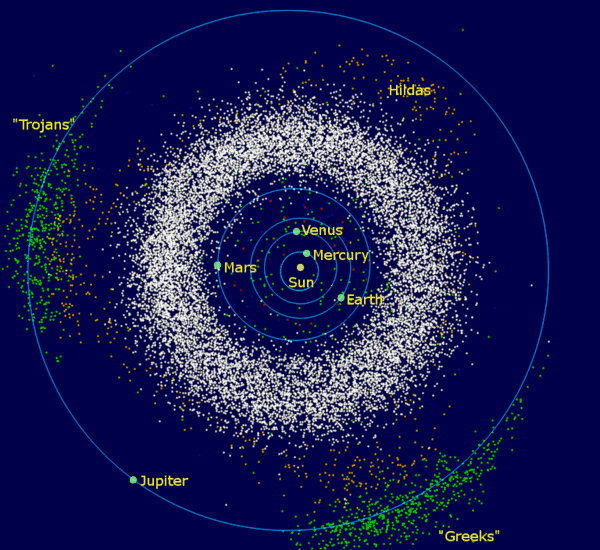
They are a type of co-orbital objects. For example, a star and a planet orbit about their common barycenter, which is closer to the star because it is more massive. Smaller mass objects, than both the star and planet, are subjected to a combined gravitational force that acts through this barycenter.
Formation
Trojans are rare among planets in the Solar System, except Jupiter. It is thus believed that Trojans formed at their present location around the same time as Jupiter emerged from the solar nebula. Jupiter most likely played a vital role in the gravitational perturbations that followed and scattered the Trojans.
Stability
The most crucial factor in the stability of the Trojans is the gravitational perturbations to which it is subjected. A planet with the mass of Earth, and one with that of Jupiter orbiting a star would be a stable chemistry for Trojans; however, if the Jupiter-sized planet would have the mass of Pluto, then the Trojans orbit would be much less stable.
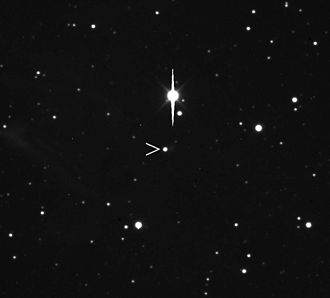
Examples of Trojans
In 1772, astronomer Joseph-Louis Lagrange developed two constant-pattern solutions – collinear and equilateral – of the general three-body problem. This expanded and became the five Lagrangian points, which are the points near two large bodies in orbit where a smaller object will maintain its position relative to the large orbiting bodies.
At first, the term “Trojan” originally referred to the Jovian Trojans that orbit close to the Lagrangian points of Jupiter. They have been named after the figures from the Greek War of Greek mythology.
Conventionally, the asteroids orbiting near the L4 point of Jupiter are named for the characters from the Greek side of the war, while those in the L5 point are called from the Trojan side.
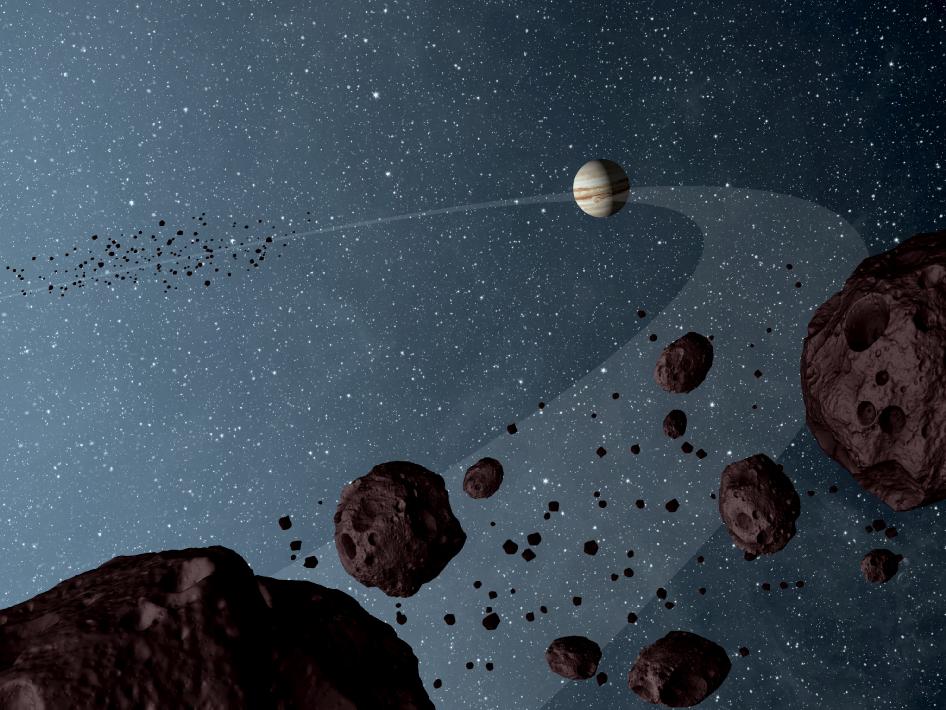
There are some exceptions to this rule of naming; however, Trojans were later discovered around other planets. Here are some examples:
Martian Trojans – currently, around four are known: 5261 Eureka, (101429) 1998 VF31, (311999) 2007 NS2, and (121514) 1999 UJ7 which is the only body in the leading cloud at L4.
Neptunian Trojans – Around 22 trojans have been discovered around Neptune. They are believed to outnumber the large Jovian Trojans by an order of magnitude.
Earth Trojans – 2010 TK7 is the first known Earth Trojan, located in the L4 Lagrangian point, ahead of Earth.
Uranus Trojans – The first Uranus Trojan discovered was 2011 QF99. It is located in the L4 Lagrangian point, and later, a second Trojan, 2014 YX49, was announced in 2017.
Venusian Trojans – Venus has only one temporary Trojan, 2013 ND15. In a similar case, the asteroids Ceres and Vesta have temporary Trojans.
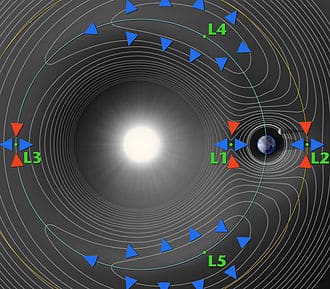
Jupiter Trojans
The Jupiter Trojans are the most numerous to date. More than 7.000 have been discovered. They are named after characters from Greek mythology concerning the Trojan War.
It is estimated that there are around 1 million Jupiter Trojans with diameters larger than 1 km / 0.6 mi. It is almost equal to the asteroids located in the asteroid belt, and just like them, they form families.
Many of them are thought to be captured objects during the early stages of the solar system’s formation or slightly later, during the migration of the giant planets. Jupiter’s Trojans are the first to be discovered and are in a class of their own.
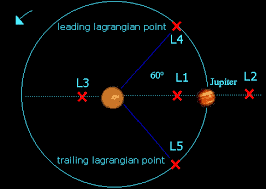
Numbers and Mass
In the L4 point, there are an estimated 160-240.000 asteroids with diameters larger than 2 km / 1.2 mi and about 600.000 with diameters larger than 1 km / 0.6 mi.
If the L5 point also contains comparable numbers, then there are more than 1 million Jupiter Trojans with 1 km / 0.6 mi diameters or even more significant.
The total mass of the Jupiter Trojans is estimated to be one-fifth of the mass of the asteroid belt, or 0.0001 the mass of Earth. The largest known Jupiter Trojan is 624 Hektor, which has an average diameter of 203 ± 3.6 km / 126 ± 2.2 mi. Little is known of the smaller Trojans, though it is believed that they reached minuscular sizes due to collisions.
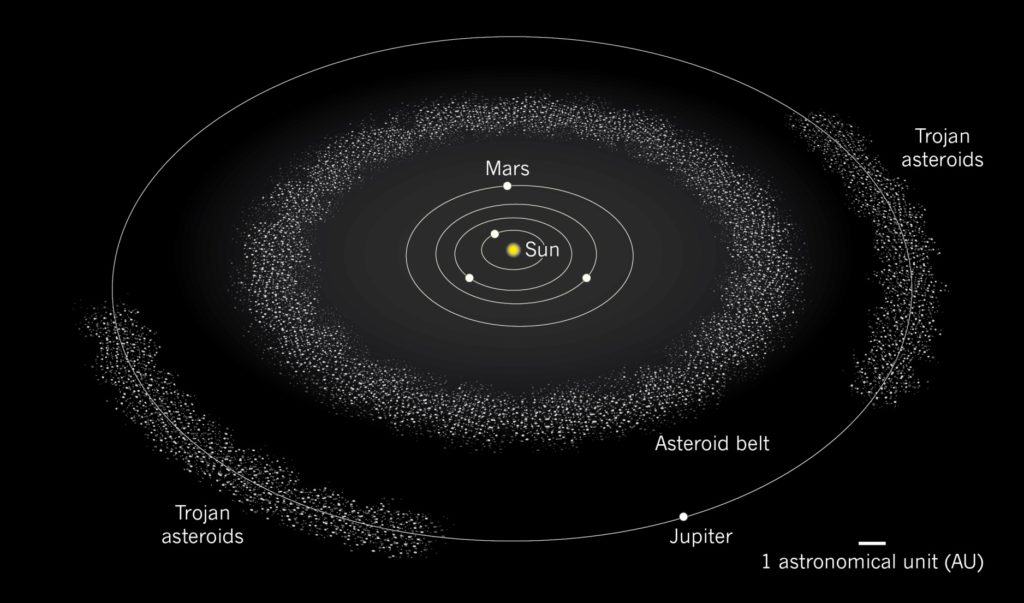
Orbits and Rotation
Usually, Jupiter Trojans have orbits with radii between 5.05 and 5.35 AU and are distributed throughout elongated, curved regions around the two Lagrangian points. Each swarm stretches for 26 degrees along the orbit of Jupiter, to a total distance of 2.5 AU.
Around 72 trojans were studied concerning their rotational characteristics. The average rotational period was established to be 11.2 hours; however, this is not the norm.
Composition
Most Jupiter Trojans are D-class asteroids, which predominate in the outer regions of the asteroid belt. Very few have been classified as P or C-type asteroids.
Water hasn’t yet been detected on any of them; however, there is a possibility that some of them might contain it. Recent studies suggest that the Jupiter Trojans resemble comets or Kuiper Belt objects when it comes to their composition, mainly water-ice with a layer of dust; however, observations continue.
The Future
Trojans will remain in our focus for an extended period since we know so little about them, especially the Jupiter Trojans. NASA has already announced a mission to explore six Jupiter Trojans starting in 2021, with the spacecraft arriving in 2027 at the L4 trojan cloud.
Did you know?
- The second-largest Jupiter Trojan is 617 Patroclus. It has a diameter of 140 km / 86.9 mi.
- The asteroid with the highest albedo of the Jupiter Trojans, and all known Trojans, is 4709 Ennomos – having an albedo of 0.18. This high albedo may indicate the presence of water-ice.
- The Jupiter Trojans 911 Agamemnon, and 617 Patroclus have very weak absorptions at 1.7 and 2.3 μm. It might indicate the presence of organics.
- Based on simulations, around 17% of Jupiter Trojans are unstable over the age of the solar system.
Sources:
Image sources:
- https://upload.wikimedia.org/wikipedia/commons/thumb/f/f3/InnerSolarSystem-en.png/465px-InnerSolarSystem-en.png
- https://upload.wikimedia.org/wikipedia/commons/thumb/d/dc/624Hektor-LB1-mag15.jpg/330px-624Hektor-LB1-mag15.jpg
- https://www.astrobio.net/images/galleryimages_images/Gallery_Image_9750.jpg
- https://upload.wikimedia.org/wikipedia/commons/thumb/8/88/Lagrange_points.jpg/330px-Lagrange_points.jpg
- https://encrypted-tbn0.gstatic.com/images?q=tbn%3AANd9GcRhdwquJMRhf0h9ZiXlkfhYi2W5Jk5tHjgg6qDIOZrLjQTDzkdK
- https://www.americaspace.com/wp-content/uploads/2017/02/Asteroid_Belt-browse-NEW.jpg
